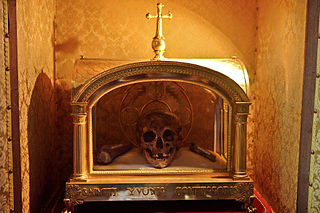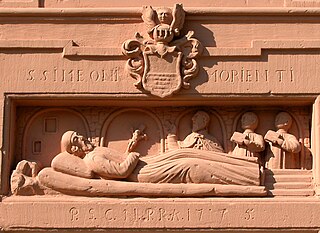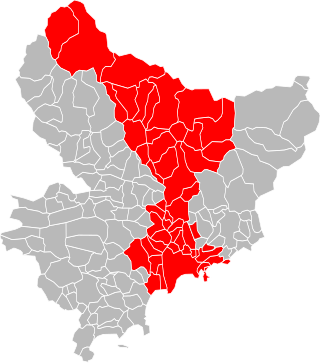Related Research Articles

In religion, a relic is an object or article of religious significance from the past. It usually consists of the physical remains or personal effects of a saint or other person preserved for the purpose of veneration as a tangible memorial. Relics are an important aspect of some forms of Buddhism, Christianity, Islam, shamanism, and many other religions. Relic derives from the Latin reliquiae, meaning "remains", and a form of the Latin verb relinquere, to "leave behind, or abandon". A reliquary is a shrine that houses one or more religious relics.

The French Riviera, known in French as the Côte d'Azur, is the Mediterranean coastline of the southeast corner of France. There is no official boundary, but it is considered to be the coastal area of the Alpes-Maritimes department, extending from the rock formation Massif de l'Esterel to Menton, at the France–Italy border, although some other sources place the western boundary further west around Saint-Tropez or even Toulon. The coast is entirely within the Alpes-Maritimes, a department within Provence-Alpes-Côte d'Azur region of France. The Principality of Monaco is a semi-enclave within the region, surrounded on three sides by France and fronting the Mediterranean. The French Riviera contains the seaside resorts of Cap-d'Ail, Beaulieu-sur-Mer, Saint-Jean-Cap-Ferrat, Villefranche-sur-Mer, Antibes, Juan-les-Pins, Cannes, and Theoule-sur-Mer.

Jean-Hippolyte Flandrin was a French Neoclassical painter. His most celebrated work, Jeune Homme Nu Assis au Bord de la Mer, from 1836, is held in the Louvre.

Saint-Jean-Cap-Ferrat is a commune in the Alpes-Maritimes department in the Provence-Alpes-Côte d'Azur region in Southeastern France. In 2012, Cap Ferrat was named the second most expensive residential location in the world after Monaco.

Villefranche-sur-Mer is a resort town in the Alpes-Maritimes department in the Provence-Alpes-Côte d'Azur region on the French Riviera and is located south-west of the Principality of Monaco, which is just west of the French-Italian border.

The Urban community of Nice Côte d'Azur, is the former intercommunal structure gathering the city of Nice (France) and some of its suburbs. It was created in December 2008.

September 30 - Eastern Orthodox liturgical calendar - October 2

September 27 - Eastern Orthodox liturgical calendar - September 29

The arrondissement of Nice is an arrondissement of France in the Alpes-Maritimes department in the Provence-Alpes-Côte d'Azur region. It has 101 communes. Its population is 522,637 (2016), and its area is 3,067.4 km2 (1,184.3 sq mi).

January 9 - Eastern Orthodox liturgical calendar - January 11
Les Azuriales Opera is an Anglo-French organisation that focuses on finding outstanding young artists and making a significant difference to their early operatic careers. Its activities take place in Cap Ferrat, Villefranche-sur-Mer and London.

Beaulieu-sur-Mer, commonly referred to simply as Beaulieu, is a seaside commune on the French Riviera between Nice and the Principality of Monaco. Located in the Alpes-Maritimes department in the Provence-Alpes-Côte d'Azur region, it borders the communes of Saint-Jean-Cap-Ferrat and Villefranche-sur-Mer, not far from Èze to the northeast. In 2018, Beaulieu-sur-Mer had a population of 3,731. Its inhabitants are called Berlugans (masculine) and Berluganes (feminine).

Cap Ferrat is a cape situated in the Alpes-Maritimes department in Southeastern France. It is located in the commune of Saint-Jean-Cap-Ferrat.
The Canton of Villefranche-sur-Mer is a French former administrative division, located in the arrondissement of Nice, in the Alpes-Maritimes département. It had 21,551 inhabitants (2012). It was disbanded following the French canton reorganisation which came into effect in March 2015. The communes of the canton joined the canton of Beausoleil.

The Diocese of Orléans is a Latin Church diocese of the Catholic Church in France. The diocese currently corresponds to the Départment of Loiret. The current bishop is Jacques André Blaquart, who was appointed in 2010.

Santa Anna was an early 16th-century carrack of the navy of the Knights Hospitaller. The war ship was celebrated for her many modern features. While some authors view her lead sheathed hull as an early form of ironclad, others regard it primarily as a means to improve her watertightness.

Saint Simeon of Trier, also Symeon, was a monk and recluse who died in Germany in 1035. He is venerated as a saint in the Eastern Orthodox Church with his feast day on May 1, and in the Catholic Church in Germany.
The Observatoire Oceanologique de Villefranche is a field campus of Sorbonne University in Villefranche-sur-Mer on the Côte d'Azur, France. It houses two research/teaching laboratories co-administered by Sorbonne University (SU) and the Centre National de la Recherche Scientifique. The two laboratories are focused on Developmental Biology, and Oceanography.

The Métropole Nice Côte d'Azur is the métropole, an intercommunal structure, centred on the city of Nice. It is located in the Alpes-Maritimes department, in the Provence-Alpes-Côte d'Azur region, Southeastern France. It was created on 31 December 2011, replacing the previous communauté urbaine of Nice Côte d'Azur and the communautés de communes of Les stations du Mercantour, La Tinée and Vésubie-Mercantour. In 2013 the commune of Coaraze left the métropole; in 2014 the communes of Bonson, Le Broc, Gattières and Gilette joined it. In 2022 the communes of Drap and Châteauneuf-Villevieille joined the métropole. Its area is 1,479.7 km2. Its population was 545,873 in 2018, of which 341,032 in Nice proper.

The canton of Beausoleil is an administrative division of the Alpes-Maritimes department, southeastern France. Its borders were modified at the French canton reorganisation which came into effect in March 2015. Its seat is in Beausoleil.
References
- ↑ (in Greek) Ὁ Ὅσιος Ὁσπίτιος ὁ Ἐρημίτης. 21 Μαΐου. ΜΕΓΑΣ ΣΥΝΑΞΑΡΙΣΤΗΣ.
